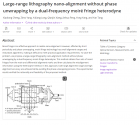The construction area is 140,000 square meters! Xinyichang's "High-end Intelligent Equipment Manufacturing Base Project" was launched.
Xinyichang High-end Intelligent Equipment Manufacturing Base Project" was held. The base is located in the east area of Cuiheng New District, Zhongshan City, covering an area of 37,687.11 square meters.
Project introduction
Xinyichang high-end intelligent equipment manufacturing base is located in the east area of Cuiheng New District, Zhongshan City, with a total investment of 600.4616 million yuan.The proposed construction area is 149,400.71 square meters. It will mainly build an intelligent equipment manufacturing base and a group R&D center (mainly including R&D offices, experiments, testing, and inspection rooms) and supporting facilities to create scale, clustering, innovation, and branding. , a demonstration base for the intelligent manufacturing industry of semiconductor intelligent equipment with independent intellectual property rights, advanced technology and a certain scale.



